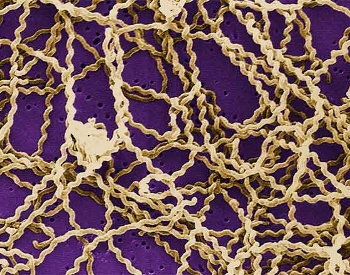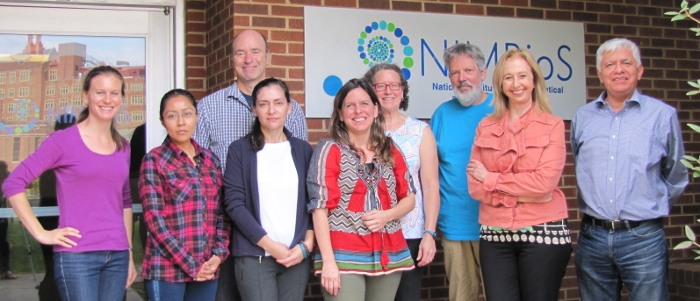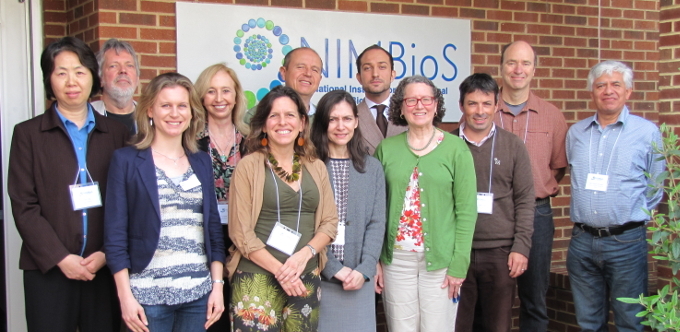| Description | Participants | Summaries | Products |
|---|

Archived NIMBioS Working Group
Leptospirosis Modeling
Topic: Mathematical modeling of Leptospira transmission and intervention strategies
Meeting dates: April 8-10, 2015; September 14-18, 2015; May 10-13, 2016; November 1-4, 2016
Organizers:
Claudia Munoz-Zanzi, Division of Epidemiology and Community Health, School of Public Health, Univ. of Minnesota
Jorge Velasco-Hernandez, Inst. of Mathematics, Universidad Nacional Autonoma de Mexico
Objectives: Leptospirosis is a zoonotic disease with complex transmission dynamics and of global importance for public and animal health. This working group will use mathematical approaches for improving our knowledge in the general areas of i) transmission dynamics at a local scale involving multi-host systems as well as one or more circulating Leptospira strains and ii) mechanisms underlying temporal and spatial patterns of leptospirosis transmission. A diverse and multidisciplinary team of experts will develop new approaches to gain insight into the processes influencing the ecology and epidemiology of leptospirosis in complex natural systems. Mathematical models will be used to provide scientifically-based recommendations on optimal interventions and surveillance programs, which can assist with effective implementation of public and animal health programs. Broader impacts include innovations in mathematical methods and in methods to investigate zoonotic infections in general.
Ideas for this working group benefited from discussions at the NIMBioS Investigative Workshop on Leptospirosis Modeling.

Meeting Summaries
| Mtg # | Dates | Agenda | Summary | Photo | Evaluation |
|---|---|---|---|---|---|
| 1 | Apr 8-10, 2015 | Link | Link | Report | |
| 2 | Sep 14-18, 2015 | Link | Link | ||
| 3 | May 10-13, 2016 | Link | Link | ||
| 4 | Nov 1-4, 2016 | Link | Report |
Meeting 1 Summary. At the first meeting of the Working Group, we reviewed a series of informal presentations summarizing the current state of knowledge and data gaps in leptospirosis transmission mechanisms, epidemiology, pathogen diversity, detection methods, and health impact in people and in animals. This was followed by an open discussion of the main research topics and study questions relevant to the areas of expertise and interests of the participants. Small groups were created based on the following general areas, which will guide specific research questions and study objectives: 1) Eco-epidemiology of leptospirosis, 2) Optimal case detection, 3) Early warning methods, and 4) Evaluation of interventions. One or more specific modeling studies were identified for each topic. Each group will be led by a mathematical modeler and a leptospirologist. Groups will begin work and share progress at the next meeting.
Meeting 2 Summary. During the second meeting of the Working Group, we continued to investigate Leptospira transmission mechanisms, possible interventions, early outbreak warning signs and early detection protocols. Updates on the models with chemoprophylaxis, early warning systems and multiple serovars systems were presented. Discussions on diagnostic protocols, interventions, single vs. multiple hosts, and types of available data were productive for formulating ecological-epidemiological models and approaches for early detection. Logistics for parameter gathering across the various modeling studies were established. Data from Thailand, Argentina, Chile, and Brazil will be used to parameterize several models to focus on specific locations.
Meeting 3 Summary. Updates were provided on current models under development focusing on ecology and transmission drivers: leptospirosis transmission in a multi-host/multi-strain system, environmental factors driving leptospirosis epidemics, and the role of dogs in urban leptospirosis. Intervention strategies are being evaluated in the areas of outbreak early warning systems, control measures portfolio management, early diagnosis of human leptospirosis cases, use of chemoprophylaxis to reduce incidence in high risk periods, and herd management to reduce transmission in cattle. Considerable time was spent on refining final details of the models as well as integrating and critically reviewing literature for parameterization.
 |
| Mtg. 4 participants (L to R): Suzanne O'Regan, Elizabeth Santiago, Matthew Gompper, Claudia Munoz-Zanzi, Andrea Previtali, Suzanne Lenhart, Rudy Hartskeerl, Cristina Schneider, Jorge Velasco-Hernandez. |
 |
| Meeting 1 participants (L to R): Zhilan Feng, Rudy A. Hartskeerl, Suzanne O'Regan, Cristina Schneider, Andrea Previtali, Alejandro de la Pena-Moctezuma, Claudia Munoz-Zanzi, Matteo Convertino, Suzanne Lenhart, Vincent Herbreteau, Matthew Gompper, Jorge Velasco-Hernandez |
 |
| Meeting 2 participants (L to R): Rudy A. Hartskeerl, Claudia Munoz-Zanzi, Suzanne Lenhart, Jorge Velasco-Hernandez, Suzanne O'Regan, Matteo Convertino, Andrea Previtali, Cristina Schneider. Not Pictured: Matthew Gompper, Alejandro de la Pena-Moctezuma. |
 |
| Meeting 3 participants (L to R): Ibrahim Aslan, Matteo Convertino, Andrea Previtali, Rudy A. Hartskeerl, Elizabeth Santiago, Matthew Gompper, Suzanne O'Regan, Suzanne Lenhart, Zhilan Feng, Claudia Munoz-Zanzi, Jorge Velasco-Hernandez, Vincent Herbreteau. |
NIMBioS Working Groups are chosen to focus on major scientific questions at the interface between biology and mathematics. NIMBioS is particularly interested in questions that integrate diverse fields, require synthesis at multiple scales, and/or make use of or require development of new mathematical/computational approaches. NIMBioS Working Groups are relatively small (up to 10 participants), focus on a well-defined topic, and have well-defined goals and metrics of success. Working Groups will meet up to 3 times over a two-year period, with each meeting lasting up to 2.5 days.
A goal of NIMBioS is to enhance the cadre of researchers capable of interdisciplinary efforts across mathematics and biology. As part of this goal, NIMBioS is committed to promoting diversity in all its activities. Diversity is considered in all its aspects, social and scientific, including gender, ethnicity, scientific field, career stage, geography and type of home institution. Questions regarding diversity issues should be directed to diversity@nimbios.org. You can read more about our Diversity Plan on our NIMBioS Policies web page. The NIMBioS building is fully handicapped accessible.
NIMBioS
1122 Volunteer Blvd., Suite 106
University of Tennessee
Knoxville,
TN 37996-3410
PH: (865) 974-9334
FAX: (865) 974-9461
Contact NIMBioS


